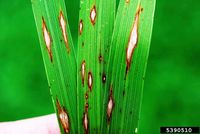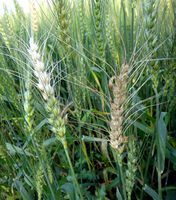Pyricularia oryzae
| Literature database |
|---|
| 1348 articles sorted by: |
| • year (descending) |
| • research topics |
| • countries/regions |
| • host plants |
| • list of antagonists |

Author(s): S. Klaubauf, D. Tharreau, E. Fournier, J.Z. Groenewald, P.W. Crous, R.P. de Vries and M.-H. Lebrun
Source: Studies in Mycology, 2014, 79, p. 113
Pyricularia oryza Cavara, 1891
The fungus causes rice blast (Oryza pathotype), a very important disease in many rice growing regions. It infects also a variety of other graminaceous hosts (e.g. it causes gray leaf spot on turf grass, perennial ryegrass pathotype). Furthermore, it infects wheat in South America (Triticum pathotype) and causes wheat blast, as does the closely related species Pyricularia graminis-tritici (see Castroagudín et al., 2016).
The fungus is believed to have a South-East Asian origin, but is now distributed in warmer and tropical regions around the world. On rice, mainly the leaves are infected and show typical diamond-shaped lesions. Panicles and leaf collars may also show symptoms. Spore production might start as soon as a week after the infection.
| Vernacular names | |
|---|---|
| • Deutsch: | Reisbrand Reisbräune |
| • English: | rice blast gray leaf spot of grasses slow-blasting of rice wheat blast neck blast of rice |
| • Español: | anublo del arroz |
| • Français: | brûlure du riz |
Conidia are usually three-celled and spindle or club-shaped with a length of around 25-30 µm. They are dispersed by rain splashes or wind. Sexual spores (ascospores) are only known from laboratory cutures. The fungus can persist and overwinter in the environment in infected plant residues.
Resistant varieties have been developed, but resistance breakdown is common. Crop rotation and avoiding the overuse of nitrogen fertilizers are recommended as additional management options. The use of fungicides is usually not economical and is considered as a control option of last resort.
Wheat blast is a serious wheat disease in parts of South America and has been also reported from Bangladesh. It can cause yield losses of up to 70%. Both, P. oryzae and Pyricularia graminis-tritici have been reported to be involved in the disease outbreaks (Castroagudín et al., 2016). Some authors regard P. graminis-tritici as the main cause of wheat blast in South America and Asia (Ceresini et al., 2019).
For a review see Tosa and Chuma, 2014.
Taxonomic notes:
The scientific name for the rice blast fungus has changed repeatedly over the years causing considerable confusion among plant pathologists.
- The fungus was originally called Pyricularia grisea (Sacc.) Sacc. 1880.
- When the teleomorph form was described as Magnaporthe grisea (T.T. Hebert) M.E. Barr 1977 that name was used because according to the taxonomic rules of that time, the sexual name should be preferred over the anamorph name.
- In 2002 Couch and Kohn pointed out that the name used for the rice blast fungus is incorrect because the species Pyricularia grisea only infects grasses of the genus Digitaria, whereas the fungus named Pyricularia oryzae Cavara 1891 infects rice and that both fungi are separate valid species. Both names had been actually used correctly for some time based mainly on the hosts from where they were isolated. However, since there were no clear morphological differences between both species they were subsequently considered synonyms with the older name (Pyricularia grisea) being preferred. By studying the DNA structure of both species Couch and Kohn demonstrated that they were indeed different. The sexual form of Pyricularia oryzae was then named Magnaporthe oryzae B.C. Couch, 2002 and that name was subsequently used for the rice blast fungus, although it took more than 5 years for most plant pathologists to adopt that change.
- In 2013 the taxonomic rules for fungi were changed to what is known as "one-fungus-one-name" and now only one name, the older one, is valid for each species, irrespective of whether the name applies to a sexual or asexual form. Therefore, Pyricularia oryzae is the valid name for the rice blast fungus and Magnaporthe oryzae a junior synonym.
- The new rules apply to species names as well as to genus names. Based on molecular re-examinations by several groups of taxonomists (see Luoa and Zhang 2013, Murata et al. 2014 and Klaubauf et al. 2014) it was concluded that the genera Pyricularia and Magnaporthe are clearly different and both are currently placed in different families. Pyricularia is defined by the type species Pyricularia grisea. Magnaporthe is defined by its type species Magnaporthe salvinii, which has now become a junior synonym of the asexual form Nakataea oryzae (see Luoa and Zhang 2013). Therefore, the name Magnaporthe has become a junior synonym of Nakataea.
- Other images of Pyricularia oryzae (IPM Images and Wikimedia Commons - click to enlarge)






